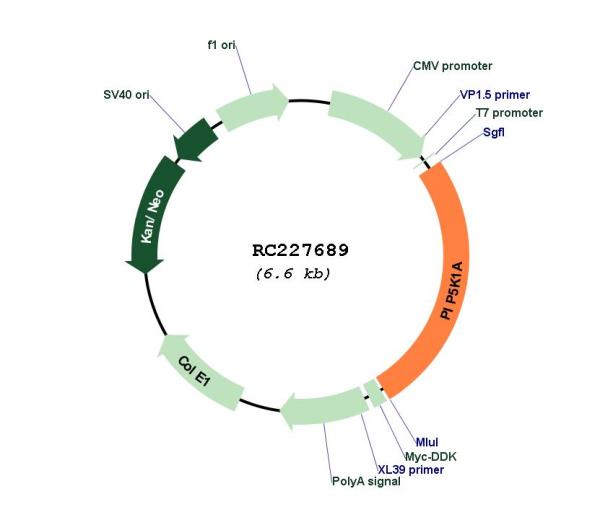PIP5K1 alpha (PIP5K1A) (NM_001135638) Human Tagged ORF Clone
CAT#: RC227689
PIP5K1A (Myc-DDK-tagged)-Human phosphatidylinositol-4-phosphate 5-kinase, type I, alpha (PIP5K1A), transcript variant 1
ORF Plasmid: tGFP
Lentiviral Particles: DDK DDK w/ Puro mGFP mGFP w/ Puro
AAV Particle: DDK
"NM_001135638" in other vectors (6)
USD 198.00
Specifications
| Product Data | |
| Type | Human Tagged ORF Clone |
| Tag | Myc-DDK |
| Symbol | PIP5K1 alpha |
| Vector | pCMV6-Entry |
| E. coli Selection | Kanamycin (25 ug/mL) |
| Mammalian Cell Selection | Neomycin |
| Sequence Data |
>RC227689 representing NM_001135638
Red=Cloning site Blue=ORF Green=Tags(s) TTTTGTAATACGACTCACTATAGGGCGGCCGGGAATTCGTCGACTGGATCCGGTACCGAGGAGATCTGCC GCCGCGATCGCC ATGGCGTCGGCCTCCTCCGGGCCGTCGTCTTCGGTCGGTTTTTCATCCTTTGATCCCGCGGTCCCTTCCT GTACCTTGTCCTCAGCAGCATCTGGAATCAAGAGACCCATGGCATCTGAGGTCTTGGAAGCTAGACAGGA TTCTTACATCTCATTGGTGCCTTATGCCTCTGGCATGCCCATCAAGAAAATAGGCCATAGAAGTGTTGAT TCCTCAGGAGAGACAACATATAAAAAGACAACCTCATCAGCCTTGAAAGGTGCCATCCAGTTAGGCATTA CCCACACTGTGGGGAGCCTGAGTACCAAACCAGAGCGTGATGTCCTCATGCAAGATTTCTACGTGGTTGA GAGTATCTTCTTTCCCAGTGAAGGGAGCAACCTGACCCCTGCTCATCACTACAATGACTTTCGTTTCAAG ACCTATGCACCTGTTGCCTTCCGCTACTTCCGGGAGCTATTTGGTATCCGGCCCGATGATTACTTGTATT CCCTCTGCAGTGAGCCGCTGATTGAACTCTGTAGCTCTGGAGCTAGTGGTTCCCTATTCTATGTGTCCAG CGACGATGAGTTCATTATTAAGACAGTCCAACATAAAGAGGCGGAATTTCTGCAGAAGCTGCTTCCAGGA TACTACATGAACCTCAACCAGAACCCTCGGACTTTGCTGCCTAAATTCTATGGACTGTACTGTGTGCAGG CAGGTGGCAAGAACATTCGGATTGTGGTGATGAACAATCTTTTACCAAGATCGGTAAAAATGCATATCAA ATATGACCTCAAAGGCTCAACCTACAAACGGCGGGCTTCCCAGAAAGAGCGAGAGAAGCCTCTTCCCACA TTTAAAGACCTAGACTTCTTACAAGACATCCCTGATGGTCTTTTTTTGGATGCTGACATGTACAACGCTC TCTGTAAGACCCTGCAGCGTGACTGTTTGGTGCTGCAGAGCTTCAAGATAATGGATTACAGCCTCTTGAT GTCAATCCATAATATAGATCATGCACAACGAGAGCCCTTAAGCAGTGAAACACAGTACTCAGTTGATACT CGAAGACCGGCCCCCCAAAAGGCTCTGTATTCCACAGCCATGGAATCCATCCAGGGAGAGGCTCGACGGG GTGGTACCATGGAGACTGATGACCATATGGGTGGCATCCCTGCCCGGAATAGTAAAGGGGAAAGGCTTCT GCTTTATATTGGCATCATTGACATTCTACAGTCTTACAGGTTTGTTAAGAAGTTGGAGCACTCTTGGAAA GCCCTGGTACATGACGGAGACACTGTCTCAGTGCATCGCCCAGGCTTCTACGCTGAACGGTTCCAGCGCT TCATGTGCAACACAGTATTTAAGAAGATTCCCTTGAAGCCTTCTCCTTCCAAAAAGTTTCGGTCTGGCTC ATCTTTCTCTCGGCGAGCAGGCTCCAGTGGCAACTCCTGCATTACTTACCAGCCATCGGTCTCTGGGGAA CACAAGGCACAAGTGACAACAAAGGCAGAAGTGGAGCCAGGCGTTCACCTTGGTCGTCCTGATGTTTTAC CTCAGACTCCACCTTTGGAGGAAATCAGTGAGGGCTCGCCTATTCCTGACCCCAGTTTCTCACCTCTAGT TGGAGAGACTTTGCAAATGCTAACTACAAGTACAACCTTGGAAAAGCTTGAAGTTGCAGAGTCAGAGTTC ACCCAT ACGCGTACGCGGCCGCTCGAGCAGAAACTCATCTCAGAAGAGGATCTGGCAGCAAATGATATCCTGGATT ACAAGGATGACGACGATAAGGTTTAA >RC227689 representing NM_001135638
Red=Cloning site Green=Tags(s) MASASSGPSSSVGFSSFDPAVPSCTLSSAASGIKRPMASEVLEARQDSYISLVPYASGMPIKKIGHRSVD SSGETTYKKTTSSALKGAIQLGITHTVGSLSTKPERDVLMQDFYVVESIFFPSEGSNLTPAHHYNDFRFK TYAPVAFRYFRELFGIRPDDYLYSLCSEPLIELCSSGASGSLFYVSSDDEFIIKTVQHKEAEFLQKLLPG YYMNLNQNPRTLLPKFYGLYCVQAGGKNIRIVVMNNLLPRSVKMHIKYDLKGSTYKRRASQKEREKPLPT FKDLDFLQDIPDGLFLDADMYNALCKTLQRDCLVLQSFKIMDYSLLMSIHNIDHAQREPLSSETQYSVDT RRPAPQKALYSTAMESIQGEARRGGTMETDDHMGGIPARNSKGERLLLYIGIIDILQSYRFVKKLEHSWK ALVHDGDTVSVHRPGFYAERFQRFMCNTVFKKIPLKPSPSKKFRSGSSFSRRAGSSGNSCITYQPSVSGE HKAQVTTKAEVEPGVHLGRPDVLPQTPPLEEISEGSPIPDPSFSPLVGETLQMLTTSTTLEKLEVAESEF TH TRTRPLEQKLISEEDLAANDILDYKDDDDKV |
| Chromatograms |
CHROMATOGRAMS
 Sequencher program is needed, download here. |
| Restriction Sites |
SgfI-MluI
Cloning Scheme for this gene
Plasmid Map

|
| ACCN | NM_001135638 |
| ORF Size | 1686 bp |
| OTI Disclaimer | The molecular sequence of this clone aligns with the gene accession number as a point of reference only. However, individual transcript sequences of the same gene can differ through naturally occurring variations (e.g. polymorphisms), each with its own valid existence. This clone is substantially in agreement with the reference, but a complete review of all prevailing variants is recommended prior to use. More info |
| OTI Annotation | This clone was engineered to express the complete ORF with an expression tag. Expression varies depending on the nature of the gene. |
| Product Components | The ORF clone is ion-exchange column purified and shipped in a 2D barcoded Matrix tube containing 10ug of transfection-ready, dried plasmid DNA (reconstitute with 100 ul of water). |
| Reconstitution | 1. Centrifuge at 5,000xg for 5min. 2. Carefully open the tube and add 100ul of sterile water to dissolve the DNA. 3. Close the tube and incubate for 10 minutes at room temperature. 4. Briefly vortex the tube and then do a quick spin (less than 5000xg) to concentrate the liquid at the bottom. 5. Store the suspended plasmid at -20°C. The DNA is stable for at least one year from date of shipping when stored at -20°C. |
| Reference Data | |
| RefSeq | NM_001135638.2 |
| RefSeq ORF | 1689 bp |
| Locus ID | 8394 |
| UniProt ID | Q99755 |
| Cytogenetics | 1q21.3 |
| Protein Families | Druggable Genome |
| Protein Pathways | Endocytosis, Fc gamma R-mediated phagocytosis, Inositol phosphate metabolism, Metabolic pathways, Phosphatidylinositol signaling system, Regulation of actin cytoskeleton |
| MW | 62.5 kDa |
| Gene Summary | Catalyzes the phosphorylation of phosphatidylinositol 4-phosphate (PtdIns4P) to form phosphatidylinositol 4,5-bisphosphate (PtdIns(4,5)P2). PtdIns(4,5)P2 is involved in a variety of cellular processes and is the substrate to form phosphatidylinositol 3,4,5-trisphosphate (PtdIns(3,4,5)P3), another second messenger. The majority of PtdIns(4,5)P2 is thought to occur via type I phosphatidylinositol 4-phosphate 5-kinases given the abundance of PtdIns4P. Participates in a variety of cellular processes such as actin cytoskeleton organization, cell adhesion, migration and phagocytosis. Required for membrane ruffling formation, actin organization and focal adhesion formation during directional cell migration by controlling integrin-induced translocation of RAC1 to the plasma membrane. Together with PIP5K1C is required for phagocytosis, but they regulate different types of actin remodeling at sequential steps. Promotes particle ingestion by activating WAS that induces Arp2/3 dependent actin polymerization at the nascent phagocytic cup. Together with PIP5K1B is required after stimulation of G-protein coupled receptors for stable platelet adhesion. Plays a role during calcium-induced keratinocyte differentiation. Recruited to the plasma membrane by the E-cadherin/beta-catenin complex where it provides the substrate PtdIns(4,5)P2 for the production of PtdIns(3,4,5)P3, diacylglycerol and inositol 1,4,5-trisphosphate that mobilize internal calcium and drive keratinocyte differentiation. Together with PIP5K1C have a role during embryogenesis. Functions also in the nucleus where acts as an activator of TUT1 adenylyltransferase activity in nuclear speckles, thereby regulating mRNA polyadenylation of a select set of mRNAs (PubMed:18288197, PubMed:19158393, PubMed:20660631). Positively regulates insulin-induced translocation of SLC2A4 to the cell membrane in adipocytes (By similarity).[UniProtKB/Swiss-Prot Function] |
Documents
| Product Manuals |
| FAQs |
| SDS |
Resources
Other Versions
| SKU | Description | Size | Price |
|---|---|---|---|
| RC227689L1 | Lenti ORF clone of Human phosphatidylinositol-4-phosphate 5-kinase, type I, alpha (PIP5K1A), transcript variant 1, Myc-DDK-tagged |
USD 823.00 |
|
| RC227689L2 | Lenti ORF clone of Human phosphatidylinositol-4-phosphate 5-kinase, type I, alpha (PIP5K1A), transcript variant 1, mGFP tagged |
USD 823.00 |
|
| RC227689L3 | Lenti ORF clone of Human phosphatidylinositol-4-phosphate 5-kinase, type I, alpha (PIP5K1A), transcript variant 1, Myc-DDK-tagged |
USD 823.00 |
|
| RC227689L4 | Lenti ORF clone of Human phosphatidylinositol-4-phosphate 5-kinase, type I, alpha (PIP5K1A), transcript variant 1, mGFP tagged |
USD 823.00 |
|
| RG227689 | PIP5K1A (tGFP-tagged) - Human phosphatidylinositol-4-phosphate 5-kinase, type I, alpha (PIP5K1A), transcript variant 1 |
USD 723.00 |
|
| SC326069 | PIP5K1A (untagged)-Human phosphatidylinositol-4-phosphate 5-kinase, type I, alpha (PIP5K1A), transcript variant 1 |
USD 576.00 |
{0} Product Review(s)
Be the first one to submit a review






























































































































































































































































 Germany
Germany
 Japan
Japan
 United Kingdom
United Kingdom
 China
China




